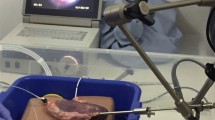Abstract
Introduction
Aim of this study was to investigate whether the combination of high-pressure irrigation inflow combined with simultaneous sensor-controlled suction could improve irrigation turnover without leading to high peak intrarenal pressure in small-calibre percutaneous instruments (SCPI).
M + M
A MIP XS sheath (9.5 Fr. outer diameter and 8.5 Fr. inner diameter) and a 7.5-Fr. nephroscope (3-Fr. irrigation channel; MIP XS by Nagele, Karl Storz, Tuttlingen, Germany) was inserted into the collecting system of a non-perfused cadaveric porcine kidney, an 8-Fr. mono-J catheter was introduced through the ureter. Irrigation was performed using a pressure-controlled, combined irrigation/suction pump (Uromat E.A.S.I., Karl Storz, Tuttlingen, Germany) in either single-flow or continuous-flow (=combination of irrigation and suction) mode. Intrarenal pressure was measured and irrigation fluid turnover was measured by a cystometry catheter inserted trans-parenchymally into the renal pelvis. Pressure changes were recorded by a urodynamic workstation.
Results
Applying pressure-controlled suction, irrigation fluid turnover could be increased by 5 % at an inflow pressure of 75 mmHg (80–84 ml/min) and 15 % at an inflow pressure of 110 mmHg (196–110 ml/min). Suction decreased the intrarenal pressure by 14 % at 75 mmHg (19–14.5 cm H2O) and 28 % at 110 mmHg inflow pressure (37–26.5 cm H2O).
Conclusion
Although combination of pressure irrigation with sensor-controlled suction increases irrigation flow in SCPI, the intrarenal pressure could be reduced with combined suction via a transurethral mono-J catheter. This irrigation method in percutaneous surgery is called purging effect.


Similar content being viewed by others
References
Bach T, Netsch C, TR Herrmann et al (2011) Objective assessment of working tool impact on irrigation flow and visibility in flexible ureterorenoscopes. J Endourol 25:1125–1129
Bader MJ, Gratzke C, Seitz M et al (2011) The “all-seeing needle”: initial results of an optical puncture system confirming access in percutaneous nephrolithotomy. Eur Urol 59:1054–1059
Ganpule AP, Bhattu AS, Desai M (2014) PCNL in the twenty-first century: role of Microperc, Miniperc, and Ultraminiperc. World J Urol [Epub ahead of print]
Guo HQ, Shi HL, Li XG et al (2008) Relationship between the intrapelvic perfusion pressure in minimally invasive percutaneous nephrolithotomy and postoperative recovery. Zhonghua Wai Ke Za Zhi 46:52–54
Gutierrez J, Smith A, Geavlete P, Shah H, Kural AR, de Sio M, Sesmero JHA, Hoznek A, de la Rosette J; CROES PCNL Study Group (2013) Urinary tract infections and post-operative fever in percutaneous nephrolithotomy. World J Urol 31:1135–1140. doi:10.1007/s00345-012-0836-y
Kawahara T, Ito H, Terao H et al (2012) Preoperative stenting for ureteroscopic lithotripsy for a large renal stone. Int J Urol 19:881–885
Kourambas J, Byrne RR, Preminger GM (2001) Does a ureteral access sheath facilitate ureteroscopy? J Urol 165:789–793
Kruck S, Anastasiadis AG, Gakis G et al (2011) Flow matters: irrigation flow differs in flexible ureteroscopes of the newest generation. Urol Res 39:483–486
Kukreja R, Desai M, Patel S et al (2004) Factors affecting blood loss during percutaneous nephrolithotomy: prospective study. J Endourol 18:715–722
Kyriazis I, Panagopoulos V, Kallidonis P et al (2014) Complications in percutaneous nephrolithotomy. World J Urol. doi:10.1007/s00345-014-1400-8
Liu C, Zhang X, Liu Y, Wang P (2013) Prevention and treatment of septic shock following mini-percutaneous nephrolithotomy: a single-center retrospective study of 834 cases. World J Urol 31(6):1593–1597. doi:10.1007/s00345-012-1002-2
Nagele U, Anastasiadis AG, Stenzl A et al (2012) Radical cystectomy with orthotopic neobladder for invasive bladder cancer: a critical analysis of long-term oncological, functional, and quality of life results. World J Urol 30:725–732
Nagele U, Horstmann M, Sievert KD et al (2007) A newly designed amplatz sheath decreases intrapelvic irrigation pressure during mini-percutaneous nephrolitholapaxy: an in vitro pressure-measurement and microscopic study. J Endourol 21:1113–1116
Traxer O, Thomas A (2013) Prospective evaluation and classification of ureteral wall injuries resulting from insertion of a ureteral access sheath during retrograde intrarenal surgery. J Urol 189:580–584
Sa Troxel, Rk Low (2002) Renal intrapelvic pressure during percutaneous nephrolithotomy and its correlation with the development of postoperative fever. J Urol 168:1348–1351
Yamaguchi A, Skolarikos A, Buchholz NPN et al (2011) Operating times and bleeding complications in percutaneous nephrolithotomy: a comparison of tract dilation methods in 5,537 patients in the Clinical Research Office of the Endourological Society Percutaneous Nephrolithotomy Global Study. J Endourol 25:933–939
Zhong W, Zeng G, Wu K et al (2008) Does a smaller tract in percutaneous nephrolithotomy contribute to high renal pelvic pressure and postoperative fever? J Endourol 22:2147–2151
Conflict of interest
None of the authors have conflict of interest concerning the data published in this article.
Ethical standard
The authors declare that the present study has been performed in accordance with the ethical standards laid down in the 1964 Declaration of Helsinki and its later amendments.
Author information
Authors and Affiliations
Corresponding author
Additional information
This is a paper from the Training and Research in Urological Surgical Therapy (T.R.U.S.T.) group.
Rights and permissions
About this article
Cite this article
Nagele, U., Walcher, U., Bader, M. et al. Flow matters 2: How to improve irrigation flow in small-calibre percutaneous procedures—the purging effect. World J Urol 33, 1607–1611 (2015). https://doi.org/10.1007/s00345-015-1486-7
Received:
Accepted:
Published:
Issue Date:
DOI: https://doi.org/10.1007/s00345-015-1486-7




